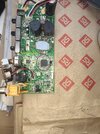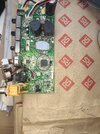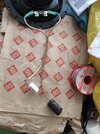Serkan_HOTEN_34
New Member
Hello,
The hkts210sub/230 subwoofer had previously broken down while making the filter circuit, the sound was very low, the STA516B amp chip had broken down, and I also suspected the STA309A13TR chip, located slightly below the STA516B, had also replaced the defective 4 22UF 16V aluminum smd capacitors with a temporary normal 22UF 16V electrolyte capacitor in my previous checks until the new one arrived yesterday STA516BETR and STA309A13TR came first, I installed the STA516BETR chip, but I got low sound and power, as with the STA517B before, and then I changed the STA309A13TR chip, but again the sound was low and powerless, so Harman The Kardon AVR265 was too low and powerless at the sound level, the hkts210sub/230 amp floor has not changed, there is nothing left except the MPC82L52AT Megawin chip.
l need help about the MPC82L52AT, an 8051-based microcontroller included in the hkts210sub/230 subwoofer amplifier board how can I check that this chip is fully functioning, how can I program it if it is broken.
How can I get the hkts210sub/230 subwoofer to produce high and powerful bass sounds again, I would be very happy if you could help me solve this problem.
Best Regard
The hkts210sub/230 subwoofer had previously broken down while making the filter circuit, the sound was very low, the STA516B amp chip had broken down, and I also suspected the STA309A13TR chip, located slightly below the STA516B, had also replaced the defective 4 22UF 16V aluminum smd capacitors with a temporary normal 22UF 16V electrolyte capacitor in my previous checks until the new one arrived yesterday STA516BETR and STA309A13TR came first, I installed the STA516BETR chip, but I got low sound and power, as with the STA517B before, and then I changed the STA309A13TR chip, but again the sound was low and powerless, so Harman The Kardon AVR265 was too low and powerless at the sound level, the hkts210sub/230 amp floor has not changed, there is nothing left except the MPC82L52AT Megawin chip.
l need help about the MPC82L52AT, an 8051-based microcontroller included in the hkts210sub/230 subwoofer amplifier board how can I check that this chip is fully functioning, how can I program it if it is broken.
How can I get the hkts210sub/230 subwoofer to produce high and powerful bass sounds again, I would be very happy if you could help me solve this problem.
Best Regard



